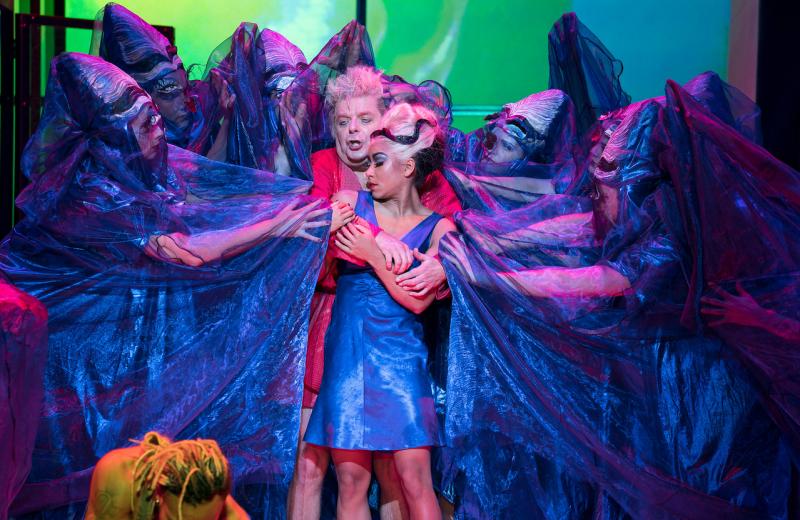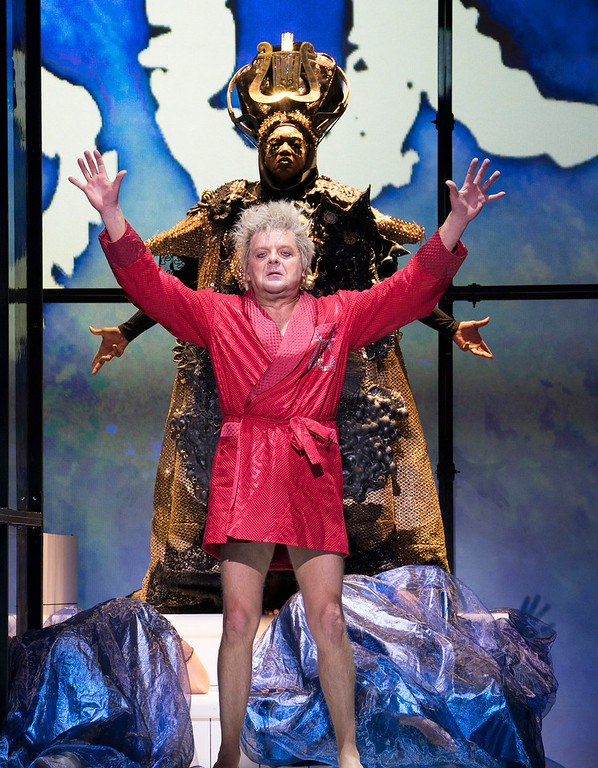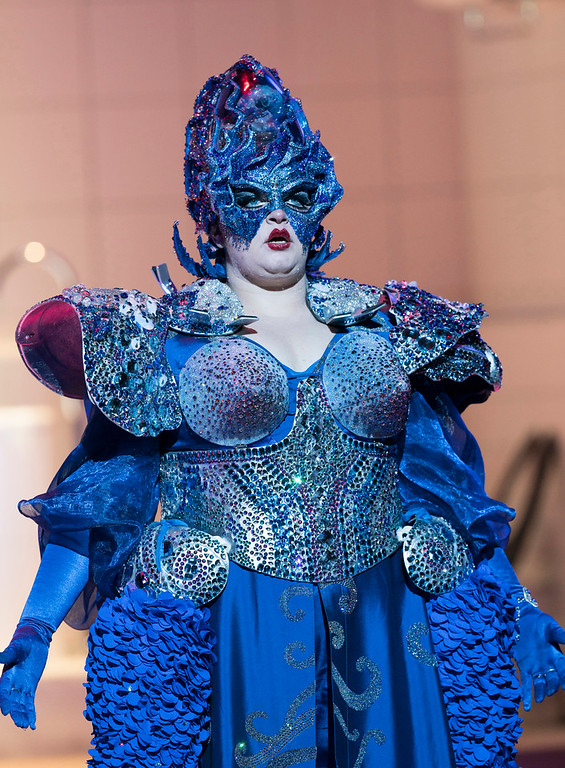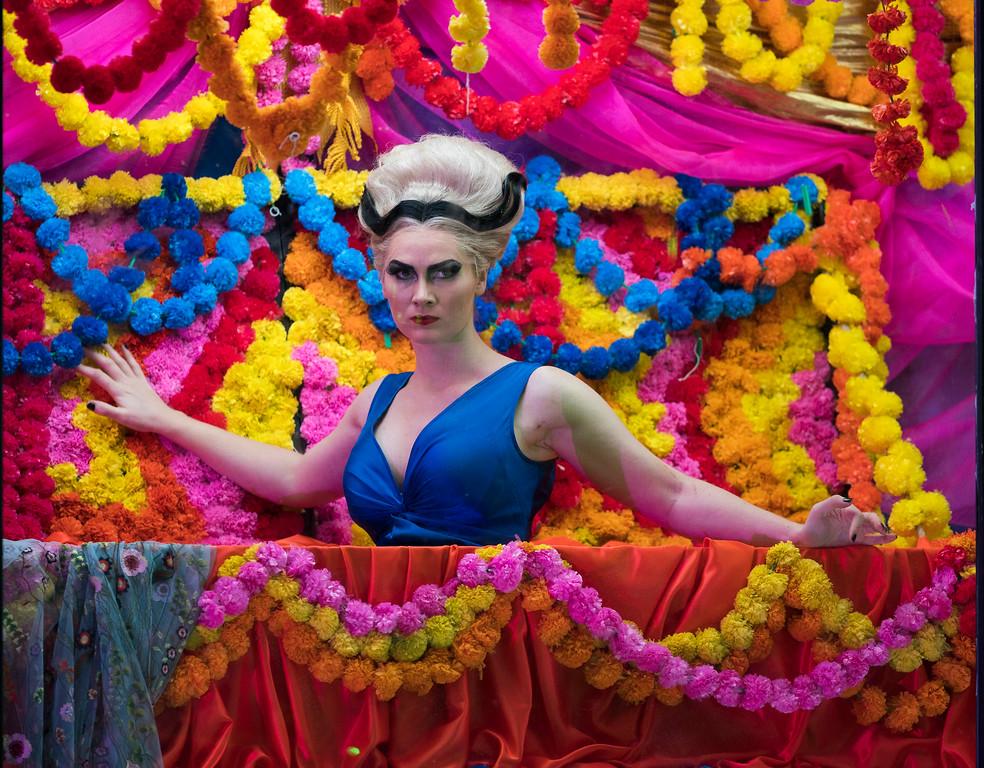The Mask of Orpheus, English National Opera review - amorphous excess | reviews, news & interviews
The Mask of Orpheus, English National Opera review - amorphous excess
The Mask of Orpheus, English National Opera review - amorphous excess
Daniel Kramer's camp carnival defuses any focus in Birtwistle's bruising score

Advance publicity overstated the case for The Mask of Orpheus. "Iconic"? Only to academics and acolytes, for British audiences haven't had a chance to see a production since ENO's world premiere run in 1986. "Masterpiece"?
Respect, though, for Birtwistle's long and punishing score as well as its valiant performers. Certainly its persistence is important for the history of opera, if not (arguably) for opera. Slice into any part of the overripe fruit and the multicoloured mottling is impressive. Striking clarinet parts, rising to screams, bending lines and growling, turbulent brass have become a Birtwistle hallmark - too repetitiously so, some might argue. Yet while you have to admire a composer so persistent in his non-linear arguments, The Mask of Orpheus came, in 1986, as a gelatinous disappointment after the specific music Birtwistle had written for Peter Hall's groundbreaking, multimasked National Theatre production of The Oresteia.
 Both approaches to Greek myth seemed to celebrate it for its apartness, its primitive roots, rather than what it has to tell us today. Which is fine when spoken word dictates the pace. Here, as in Gawain, vocal lines mostly seem plastered at random over a thick instrumental paste which seems to have no interest in telling a clear story. Add to that the electronic interludes of the outer acts and the one towards the end of the seminal second, evolved by Birtwistle and Barry Anderson at Paris's Institute for Research and Co-Ordination of Acoustics and Music (IRCAM), and the interchange and interplay of orchestra and recording hold just about enough interest over three long hours.
Both approaches to Greek myth seemed to celebrate it for its apartness, its primitive roots, rather than what it has to tell us today. Which is fine when spoken word dictates the pace. Here, as in Gawain, vocal lines mostly seem plastered at random over a thick instrumental paste which seems to have no interest in telling a clear story. Add to that the electronic interludes of the outer acts and the one towards the end of the seminal second, evolved by Birtwistle and Barry Anderson at Paris's Institute for Research and Co-Ordination of Acoustics and Music (IRCAM), and the interchange and interplay of orchestra and recording hold just about enough interest over three long hours.
Add Kramer to the mix, though, and the multiple stories with their action replays, which need absolute rigour, get smothered in what's supposed to be a savage parade but looks, thanks to costume designer Daniel Lismore's glittering excess, more like a Swarovski-themed runway pageant in RuPaul's Drag Race (which is not to denigrate Lismore; Ru's American queens can be magisterial in their invention). Orpheus 1 is an old rock star - that idea seems to get lost later on - clambering out of a bath like a raddled Eddie Izzard to turn into Danny La Rue (pictured above with Claron McFadden), though every praise to Peter Hoare for stamping his vivid vocal identity upon a taxingf role created by the late, great Philip Langridge. The supporting men are just clowns: Kramer seems to be replaying the Birwistle opera with which he had some success, Punch and Judy.
 It eventually transpires that Kramer is going for a Day of the Dead pageant, cued perhaps by Damien Hirst's glitter-encrusted skull. What do we get to understand? That the relationship of three Orpheuses and three Eurydices (Claire Barnett-Jones pictured right) - here sometimes more - has been an abusive one, that the woman gets finally to enact her vengeance on the man. Kramer respects the repetitions, giving us something to hold on to. Don't ask where the babies, bits of which get put through a blender in Act Two, come into it. There are flashes of recognition in the other tales being told as a glass box glides across the stage - that must be Venus Anadyomene with her shell-covered pudenda, that Adonis with a boar tusk, though the rest are anyone's guess - and the choreography, by Barnaby Booth, works well with the difficulty of Birtwistle's subterranean rhythmic drive.
It eventually transpires that Kramer is going for a Day of the Dead pageant, cued perhaps by Damien Hirst's glitter-encrusted skull. What do we get to understand? That the relationship of three Orpheuses and three Eurydices (Claire Barnett-Jones pictured right) - here sometimes more - has been an abusive one, that the woman gets finally to enact her vengeance on the man. Kramer respects the repetitions, giving us something to hold on to. Don't ask where the babies, bits of which get put through a blender in Act Two, come into it. There are flashes of recognition in the other tales being told as a glass box glides across the stage - that must be Venus Anadyomene with her shell-covered pudenda, that Adonis with a boar tusk, though the rest are anyone's guess - and the choreography, by Barnaby Booth, works well with the difficulty of Birtwistle's subterranean rhythmic drive.
But the big botch is the crucial second act, where Orpheus faces the 17 arches of Hades and is supposed to lose Eurydice again and again. Peter Zinovieff's text is loose, but not lazy. Kramer takes the sound and fury to signify whatever you want them to, and while the outlines of a real face sometimes emerge in the score - the smokiness of a rare saxophone solo in amongst the wind, brass and percussion, the ghost of a real dance, the desolate calm after the storm - they're not to be found onstage. You realise here why the flat, non-directional vocal amplification is necessary, but it simply adds to the assault. Nevertheless Hoare, the vocal Eurydices - Marta Fontanals-Simmons (pictured above) and very promising Claire Barnett-Jones - and the mythic Andrews Sisters (Charlotte Shaw, Katie Coventry and Katie Stevenson) transcend the coarse miking. Claron McFadden does what she can with a ludicrous coloratura shriek-fest, fortunately boundaried as Ariel in Adès's The Tempest was not. The aerialists and dancers are beguiling to watch, while Martyn Brabbins and James Henshaw serve the valiant conducting honours. It's an impressive feat to have pulled off, but to what ends I'm still not sure. Kramer is now about to leave the building, his place to be taken by Annilese Miskimmon, who has a good track record in administration but barely more success on the production front. ENO stumbles on, but its performers keep yielding gold regardless; they always have and they always will.
You realise here why the flat, non-directional vocal amplification is necessary, but it simply adds to the assault. Nevertheless Hoare, the vocal Eurydices - Marta Fontanals-Simmons (pictured above) and very promising Claire Barnett-Jones - and the mythic Andrews Sisters (Charlotte Shaw, Katie Coventry and Katie Stevenson) transcend the coarse miking. Claron McFadden does what she can with a ludicrous coloratura shriek-fest, fortunately boundaried as Ariel in Adès's The Tempest was not. The aerialists and dancers are beguiling to watch, while Martyn Brabbins and James Henshaw serve the valiant conducting honours. It's an impressive feat to have pulled off, but to what ends I'm still not sure. Kramer is now about to leave the building, his place to be taken by Annilese Miskimmon, who has a good track record in administration but barely more success on the production front. ENO stumbles on, but its performers keep yielding gold regardless; they always have and they always will.
Add comment
The future of Arts Journalism
You can stop theartsdesk.com closing!
We urgently need financing to survive. Our fundraising drive has thus far raised £49,000 but we need to reach £100,000 or we will be forced to close. Please contribute here: https://gofund.me/c3f6033d
And if you can forward this information to anyone who might assist, we’d be grateful.

Subscribe to theartsdesk.com
Thank you for continuing to read our work on theartsdesk.com. For unlimited access to every article in its entirety, including our archive of more than 15,000 pieces, we're asking for £5 per month or £40 per year. We feel it's a very good deal, and hope you do too.
To take a subscription now simply click here.
And if you're looking for that extra gift for a friend or family member, why not treat them to a theartsdesk.com gift subscription?
more Opera
 The Railway Children, Glyndebourne review - right train, wrong station
Talent-loaded Mark-Anthony Turnage opera excursion heads down a mistaken track
The Railway Children, Glyndebourne review - right train, wrong station
Talent-loaded Mark-Anthony Turnage opera excursion heads down a mistaken track
 La bohème, Opera North review - still young at 32
Love and separation, ecstasy and heartbreak, in masterfully updated Puccini
La bohème, Opera North review - still young at 32
Love and separation, ecstasy and heartbreak, in masterfully updated Puccini
 Albert Herring, English National Opera review - a great comedy with depths fully realised
Britten’s delight was never made for the Coliseum, but it works on its first outing there
Albert Herring, English National Opera review - a great comedy with depths fully realised
Britten’s delight was never made for the Coliseum, but it works on its first outing there
 Carmen, English National Opera review - not quite dangerous
Hopes for Niamh O’Sullivan only partly fulfilled, though much good singing throughout
Carmen, English National Opera review - not quite dangerous
Hopes for Niamh O’Sullivan only partly fulfilled, though much good singing throughout
 Giustino, Linbury Theatre review - a stylish account of a slight opera
Gods, mortals and monsters do battle in Handel's charming drama
Giustino, Linbury Theatre review - a stylish account of a slight opera
Gods, mortals and monsters do battle in Handel's charming drama
 Susanna, Opera North review - hybrid staging of a Handel oratorio
Dance and signing complement outstanding singing in a story of virtue rewarded
Susanna, Opera North review - hybrid staging of a Handel oratorio
Dance and signing complement outstanding singing in a story of virtue rewarded
 Ariodante, Opéra Garnier, Paris review - a blast of Baroque beauty
A near-perfect night at the opera
Ariodante, Opéra Garnier, Paris review - a blast of Baroque beauty
A near-perfect night at the opera
 Cinderella/La Cenerentola, English National Opera review - the truth behind the tinsel
Appealing performances cut through hyperactive stagecraft
Cinderella/La Cenerentola, English National Opera review - the truth behind the tinsel
Appealing performances cut through hyperactive stagecraft
 Tosca, Royal Opera review - Ailyn Pérez steps in as the most vivid of divas
Jakub Hrůša’s multicoloured Puccini last night found a soprano to match
Tosca, Royal Opera review - Ailyn Pérez steps in as the most vivid of divas
Jakub Hrůša’s multicoloured Puccini last night found a soprano to match
 Tosca, Welsh National Opera review - a great company reduced to brilliance
The old warhorse made special by the basics
Tosca, Welsh National Opera review - a great company reduced to brilliance
The old warhorse made special by the basics
 BBC Proms: The Marriage of Figaro, Glyndebourne Festival review - merriment and menace
Strong Proms transfer for a robust and affecting show
BBC Proms: The Marriage of Figaro, Glyndebourne Festival review - merriment and menace
Strong Proms transfer for a robust and affecting show
 BBC Proms: Suor Angelica, LSO, Pappano review - earthly passion, heavenly grief
A Sister to remember blesses Puccini's convent tragedy
BBC Proms: Suor Angelica, LSO, Pappano review - earthly passion, heavenly grief
A Sister to remember blesses Puccini's convent tragedy

Comments
(No subject)
Fair enough, sir, I did say I
Fair enough, sir, I did say I might not have been looking in the right place, and it's a surprise to find this specific band listed in the orchestra for the 2019-20 season in the 'endpapers'. As for the ovation, it would be churlish not to join the standing ovation exclusively for the 85-year-old composer. And the current ENO habit is to paper the first night house with company friends and sponsors as well as critics, who are of course now down to a single ticket each. I'm not in the line of running down ENO - it actually hit a high watermark under the year and a bit of Mark Wigglesworth's inspired leadership, and despite management misfires since has produced some wonderful shows. But Kramer's have not been among them, and nothing I've seen by Miskimmon has showed directorial inspiration. Not that it's entirely necessary for an artistic director to excel in that sphere, and Kramer has made some good choices in the much-truncated seasons; on paper, the Orpheus idea was a good one, but it seems that none of the shows under that aegis have hit the mark so far. .
Sadly this comment is
Many thanks for a view from
Many thanks for a view from where the real opera-goers and first-timers were. Way too much glitzy toadying going on in the stalls, about ass genuine as a Swarovski diamond and jarringly at odds with the hardcore score not entirely smothered by all the onstage bling..
Please just let Leigh Bowery
I came to the evening in the
Persistent disconnect between
I was at the final